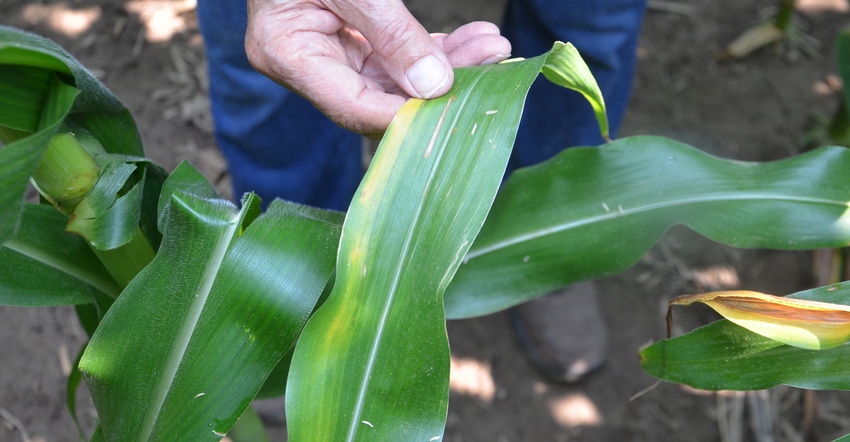
Drone flights over your cornfields can tip you off to potential trouble spots worth investigating. Yet so far, there is no replacement for walking cornfields. Just do it early in the morning and beat the heat.
Dave Nanda, director of genetics for Seed Genetics Direct, looks both for potential problems and for things that aren’t problems when he scouts corn after tasseling and pollination.
Related: Why isn’t this corn plant like the rest?
“You want to recognize any disease lesions forming on leaves and be alert for potential nutrient deficiencies while you’re in the field,” Nanda says. “You will also see things that may appear to be a problem, but which really aren’t an issue. Some stem from the remnants of pollination, like decaying pollen.
“Take a resource guide with you — either a printed manual or an app on a phone or tablet. If you are not sure what you are looking at, match it to what looks similar in the resource guide.”
If you want to be certain about which disease or deficiency you’re finding, you can send samples to a university lab. Most offer testing services in-season to identify specimens, typically at low cost with quick turnaround time.
Using the picture above as a guide, here’s how Nanda diagnosed what was happening in one field while standing at one location.
Brown lesion. The first thing that caught Nanda’s eye was the lesion on the corn leaf he’s holding. “It’s gray leaf spot, caused by a fungus,” he says. “If you find lesions on leaves near, at or above the ear leaf and weather conditions are warm and wet, consider applying a fungicide soon. You want to protect the ear leaf.”
Striping. Note the yellowish streak and striping on one side of the leaf. “The best guess is sulfur deficiency,” Nanda says. “If it was a brown rim around the edges of the leaf, it would likely be potassium deficiency. You could confirm if plants were short on sulfur by pulling 25 leaves and sending the sample to a lab for analysis. For corn at this stage, pull ear leaves.”
Firing of leaf tips. Note the firing on the leaves of a neighboring plant in the lower right corner of the picture. Yellowing and browning that start at the leaf tip and work inward are indicative of nitrogen deficiency. If it’s severe, rescue treatments might still pay. If it’s not severe, note where it occurred and reevaluate your nitrogen program for 2023.
White specks on leaves. Here’s one you don’t have to worry about, Nanda says. The white dots and specks of material are simply pollen that fell on the leaf. They will decay over time without issue.
“There is nothing to see here,” Nanda says. “Sometimes pollen collects at the base of leaf collars on the stem and turns black over time. That is a non-issue as well. Not everything you observe in a cornfield at this time of year is a problem.”
About the Author(s)
You May Also Like




